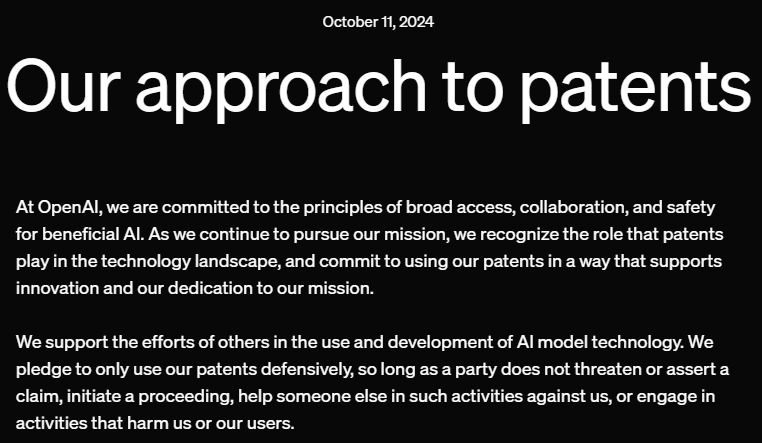by Dennis Crouch
OpenAI’s new patent pledge promises to use their patents only for defensive purposes, as long as other parties do not assert claims against them or engage in harmful activities. The move echoes Tesla CEO Elon Musk’s 2014 declaration that “all our patent … belong to you” – a pledge that garnered significant attention but left many questions unanswered. OpenAI’s pledge suffers from similar ambiguities and limitations that may ultimately render it more of a PR move than a meaningful commitment to open innovation.
OpenAI’s pledge states in part: “We support the efforts of others in the use and development of AI model technology. We pledge to only use our patents defensively, so long as a party does not threaten or assert a claim, initiate a proceeding, help someone else in such activities against us, or engage in activities that harm us or our users.”
At first glance, this may seem like a significant commitment. However, various scholars have noted in their analyses of patent pledges, the devil is in the details – or in this case, the lack thereof. See Jorge Contreras, Patent Pledges, 47 Ariz. St. L.J. 543 (2015); Catharina Maracke & Axel Metzger, Playing Nice with Patents: Do Voluntary Non-Aggression Pledges Provide a Sound Basis for Innovation?, 17 N.C. J.L. & Tech. 483 (2016). In OpenAI’s case, we might ask: What constitutes using patents “defensively”? What activities might “harm” OpenAI or its users? The pledge provides no guidance, leaving ample room for OpenAI to assert its patents aggressively while still claiming adherence to the pledge’s spirit. OpenAI’s pledge stands in stark contrast to some other patent pledges, such as IBM’s 2005 commitment not to assert 500 specific patents against open source software, which was made irrevocably.
As a relative newcomer to the patent game, the company has very little to actually pledge. While OpenAI is a market leader in LLM AI products, its patent portfolio lags tremendously. A search of USPTO records reveals only a handful of issued patents assigned to OpenAI, with several applications still pending. And, oddly, the pending applications do not appear to provide serious technology. An example of this is U.S. Patent Application No. 18/631,505 filed in 2023 – pending claim 21 is directed toward a system that uses a “language model” to edit a text:
A system comprising:
at least one processor configured to perform operations comprising:
receiving an input text prompt;
receiving one or more user instructions; and
editing, using a language model, the input text prompt based on the one or more user instructions to generate an output text by replacing at least a portion of the input text.
This claim describes a basic process of using a language model to edit text based on user instructions – a fundamental operation of many AI text-editing tools. But, the patent application does not appear to disclose fundamentally new technology for accomplishing this task. The application is being prosecuted by Folks at Finnegan Henderson, including Carlos Duarte-Guevara.
Although we cannot tell what has been newly filed over the past 18 months, the basic idea here is that OpenAI’s patent portfolio appears quite weak and so the company is is pledging not to aggressively wield its weak arsenal. True market leaders rarely need patents – until their competitors begin to catch up. OpenAI, as a current AI product leader, would see little downside in making this grand gesture about patents.
While OpenAI’s patent portfolio appears limited, the company has likely placed significant emphasis on trade secrecy to protect core technological innovations. This approach aligns with the practices of many AI companies, who view details of model training (data and hyperparameters) and model architectures as important trade secrets. By relying on trade secrecy rather than patents, OpenAI can maintain control over its most valuable intellectual property without public disclosure. This strategy may explain the company’s willingness to make broad patent pledges – while its most crucial innovations remain protected by internal security measures.

How do you assert a trade secret aggressively?
Other than to assert that the secret knowledge has been obtained by theft or deceit and without permission?
And used to the detriment of the secret’s owner.
Since you asked Robert, one way I have seen trade secrets “asserted over-aggressively” is for a corporate CPC to send threatening letters to any potentially competitive company hiring any of his corporate patent attorneys irrespective of that attorney’s knowlege of or involvement in any actual trade secrets.
Thank you, Paul
Only “using patents defensively” also covers using one’s patents to refuse to pay for licenses for infringed patents of others, not just for settling lawsuits. It does not have any value for any of the many PAE or other NPE patent owner lawsuits. Nor is that unilateral promise binding for corporate acquisitioners or bankrupcies,